The Storied Newnan
Scott S. Chandler
With its transcendant qualities and prominent distribution, the "arrowhead" has come to symbolize the legacy of the American Indian. It is used as a symbol of American iconography on everything from football helmets to forest services emblems. Along with the Hillsborough, the Newnan point type epitomizes the preeminence of Florida's collectible artifacts and is the paragon of lithic craftsmanship of the Florida Indian.
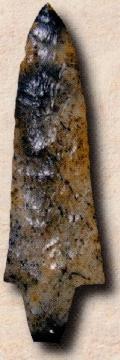
Figure 1.
Newnans are distinguished by a contracting stem or "flower pot" base as shown in Fig. 1. The ears can vary, from the straight across "Lochloosa" type in Fig. 2 to the "Tampa", style Newnan in Fig. 3 where the ears droop, creating a severe angle from the stem to the blade. Manufacturing these angles requires skill, especially when there is great symmetry to the piece.

Figure 2. (left) - Figure 3. (right)
Contributing to the attractiveness of Newnans are the colorful cherts and corals used to make them. Since Florida was a warm, shallow sea at various times, coral heads were prevalent where karst topography created outcroppings among the limestone. Knocking off pieces of agatized coral heads (Fig. 4), the Indians would take them back to camp, then bury and heat them in the sandy Florida soil. They knew the precise time (2-3 days) to heat and cool the coral for maximum chipability and exquisite color. Though raw coral is chipable, heat treating would solidify the molecular structure and create a higher grade for increased workability. Stone tools made from coral are seldom found anywhere else in the prehistoric world, and how the Indians came to emphasize such a signature point type only in Florida, one can only imagine.

It may be hard for the modern American to understand, governed by a spirit of independence and ingenuity, that of all the ways to manipulate a flint, why do we see so much conformity to established types over a broad range? Where are the prototypes, experimental models, or missing links? Like the Cambrian explosion in the fossil record, we find the settled and established forms all over the state. Why the flower pot base as the blueprint? Did it stay hafted better? Was this for cultural, or practical, reasons? And what was the purpose of taking the time to slightly distinguish the Newnan from the rounded base in a sister point called the Marion (Fig. 5), when the two styles are often found together? Perhaps the Marion was occasionally the alternate base style when a mistake was made or there was a fault in the stone. The Indian could easily cover it up by rounding off the stem.
Other types may have been "transitional" or missing links to the Newnan, but with their wide distribution, these points also became established in daily life. The transitions are difficult to pin down. Who was the actual Indian to knap out the first Newnan? How quickly did the word spread, and along what lines? Furthermore, why did the Indians take so much care in pressure flaking a stamped out base if the points were easily broken or hidden under the tar on a shaft of bone?

Figure 5.
These questions are not easily answered. But we know the attention to detail tells us the people had some sense of pride in their work. And the broad usage tells us they were a fairly rigid and conforming people, with unwritten socio-religious laws that kept them from thinking too far outside the box. Animistic in their beliefs, they enshrined spirits into their artifacts from certain animals whose qualities they admired. The gorget pictured in Fig. 6, for example, was found near the cache of 14 Newnans pictured on pages 14 and 15 and has inscribed on it a turtle shell pattern.

Figure 6.
This could have been the "Turtle Clan" where the Indians possibly worshipped the turtle for its durable qualities and consistent food source. Whether the Indians misinterpreted the spirit realm or not, the Ancients have a lot to teach modern man about the natural and spiritual worlds.
It has been proposed that even stone points took the shape of the natural world around them which the Indians observed. Certain points seem to resemble fish for example, with their tail and lines. The idea of serrations may have come from sticker bushes as they tore into the flesh of Indians walking through the forest. The aerodynamic ability of the batwing Hillsborough dart in Fig. 7, a shape only known to Florida, may have come from the strikingly similar sphinx moths found in Florida in Fig. 8. The resemblance may be pure coincidence, or they may have crafted this point in the hope of transferring the power of flight for success in the hunt from the species they admired.
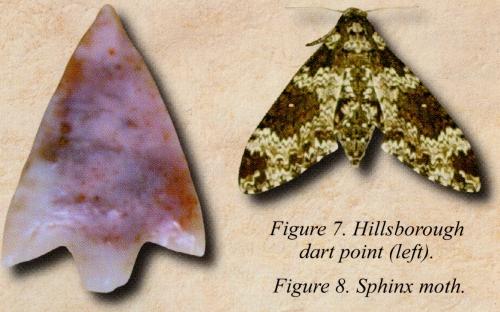
In The Decline and Fall of the Roman Empire, Edward Gibbonwrote, "The use of letters is the principal circumstance that distinguishes a civilized people from a herd of savages incapable of knowledge or reflection." Though the Indians may have been unrefined by modern standards, and did not expand thought for modern civilization, Newnan points show us the Indians were human, with the same potential capacities of the highest life form: reason, consciousness, and a desire for purpose, significance, and eternality. They maximized technological advancement on a horizontal level from primitive materials. The fine craftsmanship from the earliest Clovis people onward show no traces of transitional evolutionary brain function or missing link life form. They had a built-in instinct for order, a characteristic of intelligence. If they were primitive, it was not biological.
Certainly the Indian on occasion saw beauty in creating this fine point type, since they were widely used not only in daily life (as knives and spears), but on special occasions such as ceremonies and burials. A fine agatized piece of stone shaped into a point may have caught the deep affections of the heart of the Indian, and without doubt he held it up to the sun to view the translucence of a nice product. Precise Newnans prove Indians valued their work and probably, on occasion, had competitions to maintain a fine edge on their knapping skills.
TOOL, OR ART?
Opinions vary as to whether the Indian arrowhead is considered a piece of art or is just a tool. A prominent archeologist has said, "While spearheads are sometimes beautifully fashioned, they do not fit our definition of art." Maybe. Historically, stone has contributed to art in adornment of the body, in buildings, and in gifts of matrimony.
Perhaps the question is best answered by trying to detect motive of the manufacturer based on clues from certain finds. It is probable that some excellent pieces had religious or ceremonial value, whether in burials or in bringing increased success in gathering food. As stained glass is used for art, and not just for protection on the walls of a church, the line is crossed from tool to art where lithic objects had usages for the heart, not just the hand. Though it cannot be proven, since the permeable sandy soil does not lend itself to preserving organic material, the six point cache shown in Fig. 9 may have been part of a ritual. As with the Egyptians, perhaps the Indians believed burying beautiful lithics assisted in the passage to the afterlife. It is possible these Archaic Indians fit with what we know about historical Indians: that they valued the dead, and often buried them under their dwellings.
Because of its durability, a beautiful cache of stone points was probably the Indian's best attempt at achieving transcendence. Art tends to occur when a person is relatively secure and the mind is free to perform. The seclusion of the site where these points were found reveals that the Indians flourished here. Stone was the most durable material the Indians had and reveals that art, like a sunset, cannot be possessed but only appreciated. Thoreau wrote in 1856, "Time will soon destroy the works of famous painters and sculptors, but the Indian arrowhead will balk his efforts."
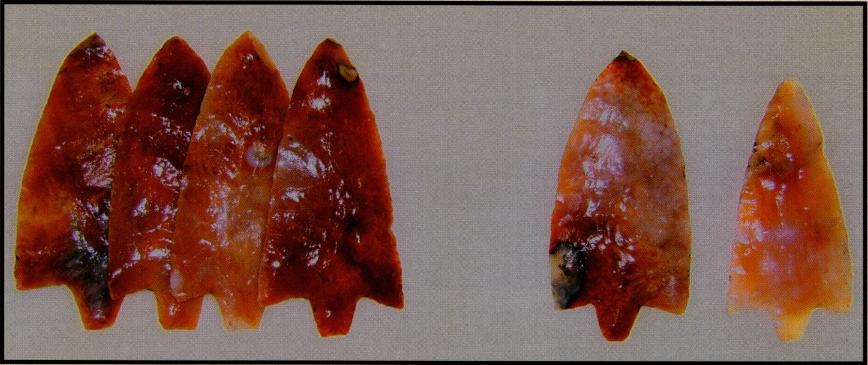
Since food was necessary for survival and their religion was tied to their hunting and gathering success, the arrowhead was sacred. In this sense, fine points can be considered art. Intentionally burying fine Newnans represented the highest offering of the most significant emblem of the Indians' survival. Finding a well made Newnan is the treasure of a lifetime, and discovering a cache of this magnitude is extremely rare. The points shown in Fig. 9 are made from high grade, thermally altered agatized coral.
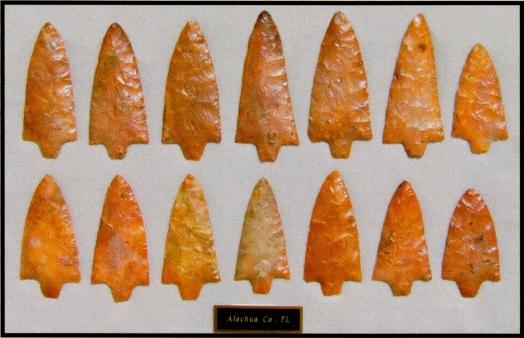
Figure 10.
The cache of 14 points shown in Fig. 10 was found in central Florida and is made of Ocala formation rice grain chert. Six of the points have a flute going up the base. Remarkably, in this cache 11 of the points have an exact match in terms of length. Only three of the 14 points do not match, but these are only off by 1/4". For ancient resources, this shows serious intent. Why they were manufactured in pairs in this case is not known. And interestingly, the points were found stacked point to base from top to bottom as shown in Fig. 11.
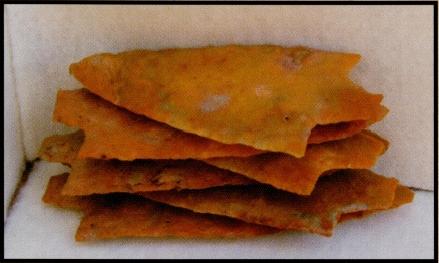
Figure 11.
Someone has said that the standard for the big point is around 4". Why are there more points found under the 4" barrier than over? First, when the bow was introduced, an extraordinary amount of smaller points were fashioned for this mechanism. Second, the source materials the Indians could manage to bring back to camp could not support very many large points. Since a well made point may take an hour or two to make and yet be broken in a moment, it would not be economically wise to keep making one point when they could make two or three out of the same rock. Though many smaller points are reworked from bigger ones, a smaller point could do most of the work of a big point. It has been proven at knap-ins that a 21/2" point could dress a whole deer. When a cache of points over 4" is found, it is remarkable.
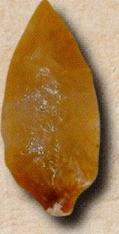
Figure 12.

Florida archeology has been a mystery to unravel at times. With so many chips mixed up and spread out in the sandy soil in a given site, there is often little correlation between the chips and the points found. One can find the most beautiful striated coral chips, while the point found nearby is field grade, made of a white coastal plain chert with little apparent association. Furthermore, Early Archaic points are often found higher in the strata than Middle or Late Archaic points. For example, this Early Archaic Thonotosassa (Fig. 12), a point supposedly made earlier than the Newnan, was found in the high Mississippian layer completely vertical, much higher than the Newnans found below (Fig. 13). These anomalies have lead archeologists to coin the term "bioturbation", which describes forces of nature that manipulate the soil and redistribute the artifacts. The problem is that when a cache is found intact in these sites, such as these found stacked point to base, it seems to contradict this theory of bioturbation. Why, in a given site, is there so much random dispersion of artifacts, and yet in places order is preserved when caches are found at the same spots? These finds challenge us to refine our understanding about who these people were and how they lived.
Duplicated from the “Resources” section of arrowheads.com and reproduced with permission.
Scott S. Chandler
With its transcendant qualities and prominent distribution, the "arrowhead" has come to symbolize the legacy of the American Indian. It is used as a symbol of American iconography on everything from football helmets to forest services emblems. Along with the Hillsborough, the Newnan point type epitomizes the preeminence of Florida's collectible artifacts and is the paragon of lithic craftsmanship of the Florida Indian.

Figure 1.
Newnans are distinguished by a contracting stem or "flower pot" base as shown in Fig. 1. The ears can vary, from the straight across "Lochloosa" type in Fig. 2 to the "Tampa", style Newnan in Fig. 3 where the ears droop, creating a severe angle from the stem to the blade. Manufacturing these angles requires skill, especially when there is great symmetry to the piece.

Figure 2. (left) - Figure 3. (right)
Contributing to the attractiveness of Newnans are the colorful cherts and corals used to make them. Since Florida was a warm, shallow sea at various times, coral heads were prevalent where karst topography created outcroppings among the limestone. Knocking off pieces of agatized coral heads (Fig. 4), the Indians would take them back to camp, then bury and heat them in the sandy Florida soil. They knew the precise time (2-3 days) to heat and cool the coral for maximum chipability and exquisite color. Though raw coral is chipable, heat treating would solidify the molecular structure and create a higher grade for increased workability. Stone tools made from coral are seldom found anywhere else in the prehistoric world, and how the Indians came to emphasize such a signature point type only in Florida, one can only imagine.

It may be hard for the modern American to understand, governed by a spirit of independence and ingenuity, that of all the ways to manipulate a flint, why do we see so much conformity to established types over a broad range? Where are the prototypes, experimental models, or missing links? Like the Cambrian explosion in the fossil record, we find the settled and established forms all over the state. Why the flower pot base as the blueprint? Did it stay hafted better? Was this for cultural, or practical, reasons? And what was the purpose of taking the time to slightly distinguish the Newnan from the rounded base in a sister point called the Marion (Fig. 5), when the two styles are often found together? Perhaps the Marion was occasionally the alternate base style when a mistake was made or there was a fault in the stone. The Indian could easily cover it up by rounding off the stem.
Other types may have been "transitional" or missing links to the Newnan, but with their wide distribution, these points also became established in daily life. The transitions are difficult to pin down. Who was the actual Indian to knap out the first Newnan? How quickly did the word spread, and along what lines? Furthermore, why did the Indians take so much care in pressure flaking a stamped out base if the points were easily broken or hidden under the tar on a shaft of bone?

Figure 5.
These questions are not easily answered. But we know the attention to detail tells us the people had some sense of pride in their work. And the broad usage tells us they were a fairly rigid and conforming people, with unwritten socio-religious laws that kept them from thinking too far outside the box. Animistic in their beliefs, they enshrined spirits into their artifacts from certain animals whose qualities they admired. The gorget pictured in Fig. 6, for example, was found near the cache of 14 Newnans pictured on pages 14 and 15 and has inscribed on it a turtle shell pattern.

Figure 6.
This could have been the "Turtle Clan" where the Indians possibly worshipped the turtle for its durable qualities and consistent food source. Whether the Indians misinterpreted the spirit realm or not, the Ancients have a lot to teach modern man about the natural and spiritual worlds.
It has been proposed that even stone points took the shape of the natural world around them which the Indians observed. Certain points seem to resemble fish for example, with their tail and lines. The idea of serrations may have come from sticker bushes as they tore into the flesh of Indians walking through the forest. The aerodynamic ability of the batwing Hillsborough dart in Fig. 7, a shape only known to Florida, may have come from the strikingly similar sphinx moths found in Florida in Fig. 8. The resemblance may be pure coincidence, or they may have crafted this point in the hope of transferring the power of flight for success in the hunt from the species they admired.

In The Decline and Fall of the Roman Empire, Edward Gibbonwrote, "The use of letters is the principal circumstance that distinguishes a civilized people from a herd of savages incapable of knowledge or reflection." Though the Indians may have been unrefined by modern standards, and did not expand thought for modern civilization, Newnan points show us the Indians were human, with the same potential capacities of the highest life form: reason, consciousness, and a desire for purpose, significance, and eternality. They maximized technological advancement on a horizontal level from primitive materials. The fine craftsmanship from the earliest Clovis people onward show no traces of transitional evolutionary brain function or missing link life form. They had a built-in instinct for order, a characteristic of intelligence. If they were primitive, it was not biological.
Certainly the Indian on occasion saw beauty in creating this fine point type, since they were widely used not only in daily life (as knives and spears), but on special occasions such as ceremonies and burials. A fine agatized piece of stone shaped into a point may have caught the deep affections of the heart of the Indian, and without doubt he held it up to the sun to view the translucence of a nice product. Precise Newnans prove Indians valued their work and probably, on occasion, had competitions to maintain a fine edge on their knapping skills.
TOOL, OR ART?
Opinions vary as to whether the Indian arrowhead is considered a piece of art or is just a tool. A prominent archeologist has said, "While spearheads are sometimes beautifully fashioned, they do not fit our definition of art." Maybe. Historically, stone has contributed to art in adornment of the body, in buildings, and in gifts of matrimony.
Perhaps the question is best answered by trying to detect motive of the manufacturer based on clues from certain finds. It is probable that some excellent pieces had religious or ceremonial value, whether in burials or in bringing increased success in gathering food. As stained glass is used for art, and not just for protection on the walls of a church, the line is crossed from tool to art where lithic objects had usages for the heart, not just the hand. Though it cannot be proven, since the permeable sandy soil does not lend itself to preserving organic material, the six point cache shown in Fig. 9 may have been part of a ritual. As with the Egyptians, perhaps the Indians believed burying beautiful lithics assisted in the passage to the afterlife. It is possible these Archaic Indians fit with what we know about historical Indians: that they valued the dead, and often buried them under their dwellings.
Because of its durability, a beautiful cache of stone points was probably the Indian's best attempt at achieving transcendence. Art tends to occur when a person is relatively secure and the mind is free to perform. The seclusion of the site where these points were found reveals that the Indians flourished here. Stone was the most durable material the Indians had and reveals that art, like a sunset, cannot be possessed but only appreciated. Thoreau wrote in 1856, "Time will soon destroy the works of famous painters and sculptors, but the Indian arrowhead will balk his efforts."

Since food was necessary for survival and their religion was tied to their hunting and gathering success, the arrowhead was sacred. In this sense, fine points can be considered art. Intentionally burying fine Newnans represented the highest offering of the most significant emblem of the Indians' survival. Finding a well made Newnan is the treasure of a lifetime, and discovering a cache of this magnitude is extremely rare. The points shown in Fig. 9 are made from high grade, thermally altered agatized coral.

Figure 10.
The cache of 14 points shown in Fig. 10 was found in central Florida and is made of Ocala formation rice grain chert. Six of the points have a flute going up the base. Remarkably, in this cache 11 of the points have an exact match in terms of length. Only three of the 14 points do not match, but these are only off by 1/4". For ancient resources, this shows serious intent. Why they were manufactured in pairs in this case is not known. And interestingly, the points were found stacked point to base from top to bottom as shown in Fig. 11.

Figure 11.
Someone has said that the standard for the big point is around 4". Why are there more points found under the 4" barrier than over? First, when the bow was introduced, an extraordinary amount of smaller points were fashioned for this mechanism. Second, the source materials the Indians could manage to bring back to camp could not support very many large points. Since a well made point may take an hour or two to make and yet be broken in a moment, it would not be economically wise to keep making one point when they could make two or three out of the same rock. Though many smaller points are reworked from bigger ones, a smaller point could do most of the work of a big point. It has been proven at knap-ins that a 21/2" point could dress a whole deer. When a cache of points over 4" is found, it is remarkable.

Figure 12.

Florida archeology has been a mystery to unravel at times. With so many chips mixed up and spread out in the sandy soil in a given site, there is often little correlation between the chips and the points found. One can find the most beautiful striated coral chips, while the point found nearby is field grade, made of a white coastal plain chert with little apparent association. Furthermore, Early Archaic points are often found higher in the strata than Middle or Late Archaic points. For example, this Early Archaic Thonotosassa (Fig. 12), a point supposedly made earlier than the Newnan, was found in the high Mississippian layer completely vertical, much higher than the Newnans found below (Fig. 13). These anomalies have lead archeologists to coin the term "bioturbation", which describes forces of nature that manipulate the soil and redistribute the artifacts. The problem is that when a cache is found intact in these sites, such as these found stacked point to base, it seems to contradict this theory of bioturbation. Why, in a given site, is there so much random dispersion of artifacts, and yet in places order is preserved when caches are found at the same spots? These finds challenge us to refine our understanding about who these people were and how they lived.
Duplicated from the “Resources” section of arrowheads.com and reproduced with permission.